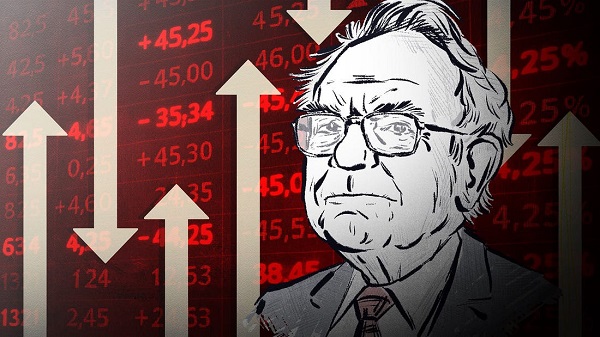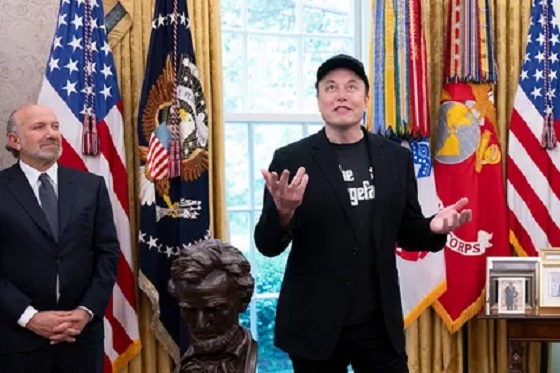Business
The Oracle of Omaha Calls it a Career

By Eric Salzman
Sometimes even the great ones need to get by with a little help from their friends
Warren Buffett announced this month that he will retire from his position as CEO of Berkshire Hathaway, the fabled corporate conglomerate that made him a revered household name, at the end of 2025. Along with a mostly stellar seven–decade investment career, he carefully created an image of a down to earth midwesterner who lives in a modest home, drives a modest car and dines on Dairy Queen (he liked DQ so much he bought the company in 1997) while swigging Coca Cola (another great Berkshire investment) and dispensing sage advise the way your favorite uncle might.
I have a six degrees of separation story where I sort of crossed paths with him. In fact, I can say that I played a small part in Buffett’s dumping of one of his favorite and most profitable trades, Freddie Mac.
Racket News is supported by readers. Consider becoming a free or paid subscriber.
Up until 2000, Warren Buffett’s Berkshire Hathaway owned a big piece of Freddie Mac (he first purchased Freddie stock in 1988), and it was one of Berkshire’s top performers. Buffett has always loved insurance companies, especially ones that generate lots of float (getting cash that you may or may not have to pay out later). That is what Freddie Mac, along with its “rival” Fannie Mae, had in spades. The government-sponsored enterprises had a duopoly on insuring the credit on trillions of American single and multi-family mortgages.
The events that caused Buffett to sell his entire stake in Freddie Mac took place in 1999, right about the time that I arrived at Freddie Mac as the risk manager of one of its divisions.
In February 1999 I was called into a meeting, a top-secret one! Freddie Mac had been sore forever that it was never able to catch up to its big sister Fannie Mae and get a 50% share of the mortgage insurance business. The split always toggled between 55-45 and 60-40 in Fannie’s favor. Freddie had tried many different schemes to achieve parity, and all had failed. Now it was time to go with the nuclear option, kind of like when the Soviet Union put nukes in Cuba.
Freddie made a deal with mortgage giant Wells Fargo. The bank agreed to let Freddie securitize all Wells Fargo loans for two years.
Freddie was confident the deal would allow it to catch up to Fannie Mae. Freddie was also confident that Fannie Mae would just passively accept it.
My small role in this scheme was to approve a massive new three-month credit risk line for Wells. Honestly, the risk that Wells Fargo would go belly up with no warning in any three-month period wasn’t really an issue, so I said sure and signed off.
In the eyes of Freddie, it was a great deal for both sides. Freddie would capture the elusive market share it desired and Wells would be able to insure loans at a cheaper rate, which meant higher profits.
Freddie also made deals with other banks. Wells got the biggest discount, but all were paying less than they were before to insure loans.
Unfortunately, within about a week, Fannie burst Freddie’s parity fantasy by signing up giants like Countrywide, also for much lower insurance rates, and with that, the race to the bottom of mortgage credit insurance was on! Actually, I would say that this was the first event in what would eventually become the Financial Crisis of 2008.
Warren Buffett took one look at this insanity of a duopoly engaging in a bitter price war and sold his entire stake in Freddie Mac. Interestingly, Berkshire was also a big investor in Wells Fargo, so Buffett got to see both sides of this strategy and chose correctly to go with the recipient of Freddie’s largesse, Wells.
However, my man-crush on Buffett ended in 2008.
One additional trait that many found endearing in Buffett was he could be very candid about his occasional losses and mistakes. He would often use these instances to impart some really great advice. However, the one thing I never heard him discuss was the times he should have lost but got the kind of help regular folks don’t get.
Buffett’s long-time business partner, Charlie Munger, once said “Suck it in and cope, buddy” in response to complaints that the government did more to help Wall Street than homeowners during the 2000’s housing crisis.
The truth is, Buffett, Munger and Berkshire would have had to do a lot of sucking themselves if not for the massive government bailout of the financial system in 2008.
This part of the story started between 2003 and 2004. Berkshire made huge option bets that four major global stock indices — the S&P 500, the Nikkei 225, the Euro Stoxx 50 and the FTSE 100 — would not end up lower than they were at the time of the trade, 10 or 15 years in the future. Berkshire sold these options to major Wall Street banks and in return, the banks paid Berkshire approximately $4.9 billion in what are called premiums. If the stock indices ended lower than their current levels, Berkshire would pay the banks the difference and, if necessary, more than the $4.9 billion it was paid.
In turn, if the indices ended at or higher than current levels, Berkshire would get to keep all the money.
Normally, companies that sell these types of long-term options have to put up collateral. Berkshire did not. With Buffet at the helm, Berkshire was considered riskless. This was the key to the strategy. Berkshire could use the $4.9 billion however it wanted without having to tie up any of Berkshire’s other assets.
As long as nothing went horribly wrong, this was a genius move. Buffett would just do his usual brilliant investing with the funds and even if the stock indices ended somewhat lower when the deals expired a decade or two later, the money he would have to pay on the options would probably pale in comparison to the money he would have made with those billions in premiums he received.
Again, unless something went horribly wrong.
In 2008, global equity markets finally woke up to the fact that the subprime mortgage crisis was a giant asteroid hurtling straight for the global financial system and began to free-fall.
At first it appeared Buffett saw what was happening as a great opportunity. One of his famous folksy quotes after all was:
“A simple rule dictates my buying: Be fearful when others are greedy, and be greedy when others are fearful.”
In September of 2008, with Goldman Sachs taking on water with the rest of their Wall Street brethren, Berkshire invested $5 billion in perpetual preferred stock with Goldman. Berkshire would receive a 10% dividend as well as the right to buy $5 billion of common stock at $115 with a five-year term. On the day of the purchase, September 23, 2008, Goldman’s stock was at $125.05. Perhaps Buffett believed Goldman was already saved after AIG was bailed out the previous week. As long as Goldman survived, this could be one of the best returns Berkshire ever made.
However, despite the immediate bailout measures taken to save Goldman and the rest, the hits just kept coming with big banks like Citigroup, Bank of America, Wachovia and WaMu (which went into receivership two days later) on the ropes.
On October 10, 2008, Goldman Sachs’ stock closed at $88.80, down 29% from where Buffett made his Goldman investment just two weeks prior. Moreover, those options Berkshire sold on the four global stock indices, made a few years earlier were going against Berkshire as global stocks cratered.
Everyone needed a bailout, including Berkshire.
Interestingly, a few years after the crisis, CNBC wrote a piece, replete with the customary Andrew Sorkin boot-licking interview.
In October 2008, in the midst of the financial crisis, Berkshire Hathaway CEO Warren Buffett made a late-night phone call to then-Treasury Secretary Henry “Hank” Paulson, with an idea about how the government might be able to turn the economy around.
Paulson was asleep. He’d had a busy night working through various policy ideas with his team to restore confidence in Wall Street.
At the time, Congress had just passed the Emergency Economic Stabilization Act, or the “bailout bill” as it came to be known, and created a $700 billion Troubled Assets Relief Program to purchase assets of failing banks. But these actions were not enough to calm investors
Once he understood what was going on, Paulson says, he listened as Buffett “laid out an idea which was a germ of what we did.”
What he told Paulson, Buffett recalls, is that, “It might make more sense to put more capital in the banks than it would to try and buy these assets.”
Perhaps the CNBC piece should have been called How Warren Buffett Saved Himself During the Financial Crisis.
Remember, just a few weeks before Buffett’s phone call to Paulson, Buffett had put capital into Goldman and now he was losing his ass. The government putting capital into Goldman and the rest of the major banks, at the time, would save him.
Naturally, in a government bailout led by a former CEO of Goldman Sachs, Hank Paulson, the U.S. never exacted the price it should have for saving Goldman and the rest of the major Wall Street banks. In a fair world, the government bailout would have come with major strings attached.
Instead the government, aided by the Federal Reserve, saved the likes of Goldman and Morgan Stanley by giving them federal bank charters, life-saving capital and bailing out AIG. The bailout recipients then profited handsomely in the aftermath due to the Federal Reserve’s unprecedented emergency policies such as zero interest rate policy and the massive buying of U.S. Treasury securities and agency mortgage-backed securities, which the Federal Reserve kept until 2018.
Those bailed out then thanked the government for saving them by giving them back their capital. Incredibly, a Goldman Sachs story on its website says “…the firm had neither sought nor expected such an infusion of capital from the Treasury.” If you need further proof of how laughable this statement is, check out this email from a Federal Reserve Bank of New York official one day before Goldman was given a bank charter.
Berkshire’s large bets on Goldman and the four major global equity indices were also saved and they also ended up richer after the crisis than before.
Meanwhile, the average American was left to “suck it in,” cope and reflect on how greedy and silly they had been buying homes they couldn’t afford.
Warren Buffett was a brilliant investor and a very wise and interesting man. However, in 2008 the “Oracle of Omaha” moniker did not fit. He was just another guy who didn’t quite see just how big the bomb cyclone was that was coming right at him. He and Berkshire escaped financial ruin like all the other plutocrats by relying on Uncle Sam to come to their rescue.
Racket News is a reader-supported publication. Consider becoming a free or paid subscriber.
Alberta
COWBOY UP! Pierre Poilievre Promises to Fight for Oil and Gas, a Stronger Military and the Interests of Western Canada

Fr0m Energy Now
As Calgarians take a break from the incessant news of tariff threat deadlines and global economic challenges to celebrate the annual Stampede, Conservative party leader Pierre Poilievre gave them even more to celebrate.
Poilievre returned to Calgary, his hometown, to outline his plan to amplify the legitimate demands of Western Canada and not only fight for oil and gas, but also fight for the interests of farmers, for low taxes, for decentralization, a stronger military and a smaller federal government.
Speaking at the annual Conservative party BBQ at Heritage Park in Calgary (a place Poilievre often visited on school trips growing up), he was reminded of the challenges his family experienced during the years when Trudeau senior was Prime Minister and the disastrous effect of his economic policies.
“I was born in ’79,” Poilievre said. “and only a few years later, Pierre Elliott Trudeau would attack our province with the National Energy Program. There are still a few that remember it. At the same time, he hammered the entire country with money printing deficits that gave us the worst inflation and interest rates in our history. Our family actually lost our home, and we had to scrimp and save and get help from extended family in order to get our little place in Shaughnessy, which my mother still lives in.”
This very personal story resonated with many in the crowd who are now experiencing an affordability crisis that leaves families struggling and young adults unable to afford their first house or condo. Poilievre said that the experience was a powerful motivator for his entry into politics. He wasted no time in proposing a solution – build alliances with other provinces with mutual interests, and he emphasized the importance of advocating for provincial needs.
“Let’s build an alliance with British Columbians who want to ship liquefied natural gas out of the Pacific Coast to Asia, and with Saskatchewanians, Newfoundlanders and Labradorians who want to develop their oil and gas and aren’t interested in having anyone in Ottawa cap how much they can produce. Let’s build alliances with Manitobans who want to ship oil in the port of Churchill… with Quebec and other provinces that want to decentralize our country and get Ottawa out of our business so that provinces and people can make their own decisions.”
Poilievre heavily criticized the federal government’s spending and policies of the last decade, including the increase in government costs, and he highlighted the negative impact of those policies on economic stability and warned of the dangers of high inflation and debt. He advocated strongly for a free-market economy, advocating for less government intervention, where businesses compete to impress customers rather than impress politicians. He also addressed the decade-long practice of blocking and then subsidizing certain industries. Poilievre referred to a famous quote from Ronald Reagan as the modus operandi of the current federal regime.
“The Government’s view of the economy could be summed up in a few short phrases. If anything moves, tax it. If it keeps moving, regulate it. And if it stops moving, subsidize it.”
The practice of blocking and then subsidizing is merely a ploy to grab power, according to Poilievre, making industry far too reliant on government control.
“By blocking you from doing something and then making you ask the government to help you do it, it makes you reliant. It puts them at the center of all power, and that is their mission…a full government takeover of our economy. There’s a core difference between an economy controlled by the government and one controlled by the free market. Businesses have to clamour to please politicians and bureaucrats. In a free market (which we favour), businesses clamour to impress customers. The idea is to put people in charge of their economic lives by letting them have free exchange of work for wages, product for payment and investment for interest.”
Poilievre also said he plans to oppose any ban on gas-powered vehicles, saying, “You should be in the driver’s seat and have the freedom to decide.” This is in reference to the Trudeau-era plan to ban the sale of gas-powered cars by 2035, which the Carney government has said they have no intention to change, even though automakers are indicating that the targets cannot be met. He also intends to oppose the Industrial Carbon tax, Bill C-69 the Impact Assessment Act, Bill C-48 the Oil tanker ban, the proposed emissions cap which will cap energy production, as well as the single-use plastics ban and Bill C-11, also known as the Online Streaming Act and the proposed “Online Harms Act,” also known as Bill C-63. Poilievre closed with rallying thoughts that had a distinctive Western flavour.
“Fighting for these values is never easy. Change, as we’ve seen, is not easy. Nothing worth doing is easy… Making Alberta was hard. Making Canada, the country we love, was even harder. But we don’t back down, and we don’t run away. When things get hard, we dust ourselves off, we get back in the saddle, and we gallop forward to the fight.”
Cowboy up, Mr. Poilievre.
Maureen McCall is an energy professional who writes on issues affecting the energy industry.
Business
Carney’s new agenda faces old Canadian problems

From the Fraser Institute
In his June speech announcing a major buildup of Canada’s military, Prime Minister Mark Carney repeated his belief that this country faces a “hinge moment” of the sort the allied countries confronted after the Second World War.
A better comparison might be with the beginning of the war itself.
Then, the Allies found themselves at war with an autocratic state bent on their defeat and possible destruction. Now, Carney faces an antagonistic American president bent on annexing Canada through economic warfare.
Then, Canada rose to the challenge, creating the world’s third-largest navy and landing an army at Normandy on D-Day. Now, Carney has announced the most aggressive reorienting of Canada’s economic, foreign and defence policies in generations.
Polls show strong support among Canadians for this new agenda. But the old Canada is still there. It will fight back. It may yet win.
The situation certainly would have been more encouraging had Carney not inherited Justin Trudeau’s legacy of severe economic and environmental restrictions—picking economic winners and losers rather than letting the market decide—and chronic deficits. The new prime minister would do well to dismantle as much of that legacy as he can.
Some advocate a return to the more laissez-faire approach of Stephen Harper’s government. But Harper didn’t confront a belligerent president hoping to annex Canada through the “economic force” of tariff walls.
The prime minister succeeded in getting Bill C-5, which is intended to weaken at least some of the restrictions on resource development and infrastructure, passed into law. He and the premiers pledge to finally dismantle generations of internal trade and labour mobility barriers. If we must trade less with the Americans, we can at least learn to trade with ourselves.
And the prime minister deserves high praise for reversing decades of military decline through increased spending and efforts to improve procurement. If Carney accomplishes nothing more than restoring Canada’s defences, especially in the Arctic, he will be well remembered.
That said, major challenges confront the Carney agenda.
There’s much talk about a new national energy corridor. But what does that mean? One KPMG executive defined it as a “dedicated, streamlined pathway for the energy, electricity, decarbonization, transportation and digital infrastructure.”
Yes, but what does that mean?
Whatever it means, some First Nations will oppose it tooth-and-nail. Not all of them, mind you. The First Nations Major Project Coalition is dedicated to assisting First Nations in working with government and the private sector for the benefit of all. But many First Nations people consider resource development further exploitation of their ancestral lands by a colonizing power. At the first major proposal to which they do not buy in, they will take the government to court.
What investor will be willing to commit to a project that could be blocked for years as First Nations and Ottawa fight it out all the way to the Supreme Court?
The prime minister, formerly a fervent advocate of combatting climate change, now talks about developing “conventional energy,” which means oil and gas pipelines. But environmental activists will fiercely oppose those pipelines.
There is so much that could go wrong. Sweep away those internal trade barriers? Some premiers will resist. Accelerate housing development? Some mayors will resist. Expand exports to Europe and Asia? Some businesses and entrepreneurs will say it’s not worth the risk.
As for the massive increase in defence spending, where will the money come from? What will be next year’s deficit? What will be the deficit’s impact on inflation, interest rates and sovereign creditworthiness? The obstacles are high enough to make anyone wonder how much, if any, of the government’s platform will be realized. But other factors are at work as well, factors that were also present in 1939.
To execute his mandate, Carney is surrounding himself with what, back in the Second World War, were called “dollar a year men”—executives who came to Ottawa from the private sector to mobilize the economy for wartime.
In Carney’s case he has brought in Marc-André Blanchard as chief of staff and Michael Sabia as clerk of the privy council. Both are highly experienced in government and the private sector. Both are taking very large pay cuts because, presumably, they understand the gravity of the times and believe in the prime minister’s plans.
Most important, Carney’s agenda has broad support from a public that fears for the country’s future and will have little patience toward any group seeking to block the prime minister’s agenda.
Millions of Canadians want this government’s reform efforts to succeed. Those who would put it at risk of failing will have to contend with public anger. That gives Carney a shot at making real change.
-

 Daily Caller2 days ago
Daily Caller2 days agoTrump’s One Big Beautiful Bill Resets The Energy Policy Playing Field
-

 Alberta8 hours ago
Alberta8 hours agoCOWBOY UP! Pierre Poilievre Promises to Fight for Oil and Gas, a Stronger Military and the Interests of Western Canada
-

 Alberta1 day ago
Alberta1 day agoAlberta Next: Immigration
-

 Business2 days ago
Business2 days agoThe Digital Services Tax Q&A: “It was going to be complicated and messy”
-

 International2 days ago
International2 days agoElon Musk forms America Party after split with Trump
-

 Carbon Tax2 days ago
Carbon Tax2 days agoCanada’s Carbon Tax Is A Disaster For Our Economy And Oil Industry
-

 Disaster2 days ago
Disaster2 days agoTexas flood kills 43 including children at Christian camp
-

 Alberta8 hours ago
Alberta8 hours agoAlberta and Ontario sign agreements to drive oil and gas pipelines, energy corridors, and repeal investment blocking federal policies






